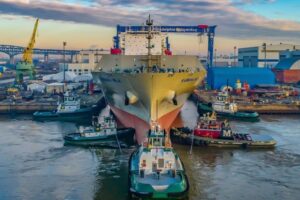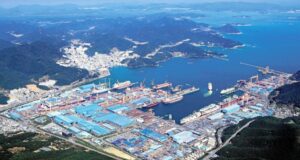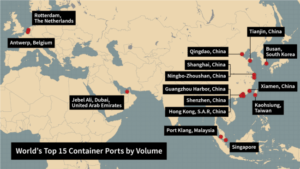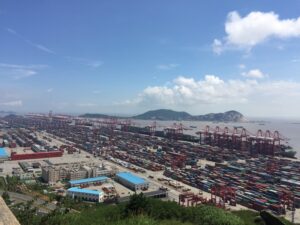PHILLY SHIPYARD
IN THIS REPORT:
CONGRESSIONAL GUIDANCE FOR A NATIONAL MARITIME STRATEGY
COSCO AND ZPMC EXPANSIONS
CHINA DEMONSTRATES WHY A U.S. MARITIME BUILD-UP MATTERS
CONCLUSION: THE NEED TO REBUILD U.S. SHIPBUILDING AND SHIPPING
BY STAS MARGARONIS, RBTUS
In a new report, Republican and Democratic Congressional representatives warned that the United States is way behind China in terms of ships and shipbuilding and needs to catch up.
One of the co-authors Senator Marco Rubio (R-FL) explained: “The competition between the United States and Communist China will define the 21st century, and nowhere is this conflict more prevalent than in the maritime domain. The U.S. must move quickly to revitalize our maritime industrial base, reinvest in a robust workforce, and advance innovative technologies to project strength and security in the world’s waterways, oceans, and seas.”[1]
The lack of a U.S. maritime presence in shipping and shipbuilding coincides with the rise of China’s naval and commercial presence. The U.S. response is growing isolationism at home while the United States falls behind not just in shipping and shipbuilding but in its investments in U.S. manufacturing, infrastructure, research and development and affordable housing.
CONGRESSIONAL GUIDANCE FOR A NATIONAL MARITIME STRATEGY
Reflecting this trend, the Republican and Democratic authored, Congressional Guidance for a National Maritime Strategy, said the United States maritime industry has suffered from “decades of neglect” allowing China to take the lead:
“Decades of neglect by the U.S. government and private industry has weakened our shipbuilding capacity and maritime workforce, contributing to a declining U.S.-flag shipping fleet to bring American goods to market and support the U.S. military during wartime. Moreover, the People’s Liberation Army Navy and the merchant marine and maritime militia of the People’s Republic of China [PRC] outnumber the U.S. Navy. For decades, our country has failed to invest in critical maritime infrastructure and capabilities. For this reason, the United States is less capable of competing in a worldwide ocean economy worth between $3 trillion and $6 trillion dollars, according to the United Nations Conference on Trade and Development. Meanwhile, our strategic competitor, the People’s Republic of China, became the world’s top shipbuilding and shipping nation, boasting 230 times more shipbuilding capacity than the United States, according to the Office of Naval Intelligence.”[2]
The Congressional report shows why an expensive and long-term effort will be required for the United States to close the gap with China:
U.S. VS CHINA
Oceangoing Vessels 200 VS 7,000 Chinese Flag Oceangoing Vessels
Shipbuilding Orders 5 VS 1,700 Orders (2023)
Shipbuilding Workers 153,000 VS 600,000 Chinese Workers
Mariners 12,000 VS 1.7 million Chinese Mariners
Source: National Maritime Strategy[3]
The report’s concerns were echoed by Jennifer Carpenter, CEO of the American Waterways Operators and President of the American Maritime Partnership who wrote: “The United States must renew its commitment to a strong, reliable American maritime capability to confront emerging threats. China’s aggressive shipping expansion poses significant challenges to the United States and our allies.”[4]
The strategy being championed by U.S. Navy Secretary Carlos Del Toro is to develop collaborations with Japanese and Korean shipbuilders and encourage them to invest in the United States.
One result of this is that Korea-based Hanwha Systems and Hanwha Ocean announced the acquisition of Philly Shipyard, a leading U.S. shipbuilder that has delivered approximately half of the large U.S. Jones Act commercial ships in the United States since 2000.
Hanwha Shipyard, South Korea (company photo)
COSCO AND ZPMC EXPANSIONS
In contrast to the United States, China’s commitment to its maritime expansion including ships, shipbuilding and terminal operations can be understood by the December 31, 2023, report by China Ocean Shipping Company (COSCO):
“1417 vessels with a total capacity of 116 million DWT, ranking No.1 in the world. Its container fleet capacity is 3.05 million TEU, ranking the fourth in the world. Its dry bulk fleet (436 vessels/46.32 million DWT), oil tanker fleet (229 vessels/28.58 million DWT) and general and specialized cargo fleet (180 vessels/6.2 million DWT) … The upstream and downstream links along the industry chain, such as shipping, terminals, logistics, shipping finance, ship repair and shipbuilding, have formed a sound industrial structure. The Corporation has invested in 57 terminals globally, including 50 container terminals. The annual handling capacity of its container terminals amounts to 133 million TEU, taking the first place worldwide.”[5]
COSCO and China’s expansion into ports around the world has been supported by ZPMC, the Shanghai-based r harbor crane builder, which has 80% of the global ship to shore crane market.
In the United States, ZPMC cranes have been the subject of criticisms in Congress that its cranes pose a security threat.
A U.S. congressional probe found questionable communications equipment on Chinese-built ship-to-shore cranes at American ports including cellular modems that could be remotely accessed, according to a report carried in the Wall Street Journal. (See: https://splash247.com/zpmc-responds-to-american-cybersecurity-concerns/#:~:text=China’s%20ZPMC%20has%20built%20up,market%20share%20of%20around%2080%25.)
ZPMC has denied a security threat exists.
However, the Biden administration is supporting estblishing a new U.S. based crane builder owned by Japan’s Paceco Mitsui to reduce the dependency on ZPMC. It seeks to impose a 25% tariff on Chinese crane imports to help protect building cranes in the United States.
The tariff is opposed by the American Association of Port Authorities.
As COSCO expands its reach with ships and new container terminals, ZPMC is expanding its technological capacity to automate container handling operations at ports in China and around the world.
A December 2023 ZPMC announcement says the company is moving into new areas of container handling automation and branching out into offshore wind developments:
“ZPMC unveiled 14 new products in port machinery and offshore engineering. As a global leader in the port machinery sector, ZPMC has maintained a leading position in the global industry for 26 consecutive years, with its products serving 107 countries and regions. The latest port machinery products include the next-generation horizontal transport trolley IGV, Model S-ASC high-speed automated rail-mounted gantry crane, the self-balancing and lifting AB quay crane, an eco-friendly and low-carbon lightweight quay crane and bulk cargo handling automation systems. The lineup also featured a novel U-shaped dock loading and unloading solution, the Portmanus terminal management system and an automated empty container yard. Additionally, ZPMC introduced the world’s largest self-propelled jack-up wind turbine installation platform, Asia’s first self-propelled offshore wind farm service operation vessel (SOV), floating wind turbine photovoltaic integration offshore engineering equipment, as well as the first set of wave compensation wharf in China and other core supporting components for offshore engineering.
In the “Building High Efficient, Green and Smart Terminals” high-level discussion segment of the main forum, executives from Guangzhou Port, Ningbo Port, COSCO Shipping Ports, China Merchants Port Group, HPH, APMT and DP World convened for a dynamic exchange on the industry’s most pressing and innovative topics such as the application of intelligent technologies in future ports, adoption of green energy, reduction of carbon emissions, and improvement of logistics efficiency.”(See: https://www.prnewswire.com/apac/news-releases/zpmc-introduces-14-new-products-and-technologies-at-2023-smart-equipment–technology-forum-302003263.html)
The biggest ports in the world are Chinese ports [6]
CHINA DEMONSTRATES WHY A U.S. MARITIME BUILD-UP MATTERS
Without substantial new investments, the United States Navy is losing ground to the PLA Navy, U.S. ocean carriers are barely a presence in global trade and without new investment and commerce countries around the world will gravitate toward China.
Bruce Jones describes in his book To Rule the Waves: How Control of the World’s Ocean Shapes the Fate of the Superpowers how China has succeeded and how the United States has failed.
Jones is a Senior Fellow at the Brookings Institute, a Washington, DC think tank and travelled extensively to China to research his book.
Jones noted that: “Eighty-five percent of all trade moves by sea … That huge scale of global shipping leads to this dramatic decline in trade costs over the period of the last seventy years. “
Jones notes: “That huge decline in the cost of transportation is really the critical factor in enabling China to participate in globalization in the 1990s and the 2000s … and what you see is the inexorable rise of China in the participation of global trade signified by the scale of ports … and the huge growth of Chinese ports. Back in the 1980s and 1990s all the largest ports are in the West and if you fast-forward to the present day … you have ports like Yangshan that are” nearly five times larger” than their nearest American competitors.”
Meanwhile, in the United States “this is a critical time when we are essentially falling out of the shipbuilding business, we are disinvesting in port infrastructure …. we are not in the infrastructurer of world trade. China takes over as the infrastructurer of world trade.”
As China has developed economically, it has begun to build up its naval presence to protect and extend its global reach.
In the 1990s and 2000s, Jones said, China realized how its economy was increasingly dependent on imports of raw materials and in turn, this situation required that it protect its sea lanes through the South China Sea and East China Sea and into Chinese ports. At the same time, China relies on the sea lanes “with exports of finished goods out going through the same route and with Chinese industrial centers linked to the ports.”
China’s policy-makers have concluded that the U.S. Navy poses a threat to China’s trade lanes and could blockade Chinese ports in a time of growing tensions.[32]
Jones noted the importance and symbolism of the new Yangshan offshore container terminal complex serving Shanghai. Yangshan is linked to Shanghai by a 30-kilometer bridge. This complex makes Shanghai the largest port in the world having processed 49 million twenty-foot container units (TEUs) in 2023.[33] This compares to 8.6 million TEUs by the Port of Los Angeles, the largest port in the United States also in 2023.[34]
The difference between U.S infrastructure spending and China’s larger investments can also be understood in another example. The infrastructure bill supported by the Biden Administration and enacted into law by Congress in 2021 contained $17 billion for all U.S. ports, according to the then Administration’s Port Envoy John Porcari. The price tag for China building the Yangshan port complex was $18 billion.[35]
Yangshan Container Complex (Photo: https://mytravels.asia/yangshan-deep-water-port/)
At a time when U.S. global carriers such as Sealand and American President Lines have disappeared, China has built up China Ocean Shipping Company (COSCO) to become a global powerhouse:.
As of Dec 31, 2023, the total fleet of COSCO SHIPPING comprises: “1417 vessels with a total capacity of 116 million DWT, ranking No.1 in the world. Its container fleet capacity is 3.05 million TEU, ranking the fourth in the world.
COSCO has also built container terminals around the world including at the new Peruvian megaport at Chancay, Peru. COSCO also owns: “logistics, shipping finance, ship repair and shipbuilding … The Corporation has invested in 57 terminals globally, including 50 container terminals. The annual handling capacity of its container terminals amounts to 133 million TEU, taking the first place worldwide”[36]
CONCLUSION: THE NEED TO REBUILD U.S. SHIPBUILDING AND SHIPPING
The assertion by Republican and Democratic congressional leaders that the United States needs to modernize its shipbuilding and shipping requires a massive long-term investment that will approximate the $52 billion investment made to support semiconductors under the CHIPS Act.
One emerging strategy being championed by U.S. Navy Secretary Carlos Del Toro is to develop collaborations with Japanese and Korean shipbuilders and encourage them to invest in the United States.
One result of this is that Korea-based Hanwha Systems and Hanwha Ocean announced the acquisition of Philly Shipyard, a leading U.S. shipbuilder that has delivered approximately half of the large U.S. Jones Act commercial ships in the United States since 2000.
The June 21st announcement said “Hanwha Systems and Hanwha Ocean will together invest $100 million to acquire Philly Shipyard to further their strategies to expand their global defense and shipbuilding activities.”[27]
Hanwha Ocean is a leading global company with extensive expertise in the shipbuilding and the offshore industry. Since 1973, the company has produced a vast range of vessels, including commercial ships, drill ships, and specialty ships.
The United States can follow China’s example and begin the long tough road of reinvesting in its maritime assets and infrastructural assets or it can just get left.
U.S. Naval Shipbuilders Disagree
U.S. Shipbuilders aired their differences with Del Toro in a Breaking Defense article ‘How SECNAV’s claims about S. Korean, Japanese shipbuilders do and do not line up’
They said that “Philly Shipyard does not build combatant ships, also called “gray hulls,” for the US Navy’s fleet, and until Hanwha’s bid is finalized, the yard is owned by a Norwegian industrial investment group. Nonetheless, the announcement was welcomed by the secretary, who said he anticipates Hanwha “will change the competitive U.S. shipbuilding landscape.”
Del Toro, in fact, has spent most of 2024 praising South Korean and Japanese shipbuilders and encouraging them to invest in American shipyards, while separately admonishing US industry for failing to invest in their own facilities and accusing them of “goosing” their stock prices.
At a surface level, his support for Asian companies seem warranted. A Hudson report published in May states that Japan (389) and South Korea (231) each built significantly more ships in 2023 than the United States (48). In 2022, it was a similar story.
But, experts tell Breaking Defense, the secretary’s praise obscures a more nuanced reality about the differences between how the US Navy’s staple shipbuilders stack up against the biggest names in Asia. Chiefly, they say, the strict requirements instituted by the Navy combined with the instability of annual congressional budgeting makes a one-to-one comparison apples and oranges.
It doesn’t mean that Del Toro is wrong with many of the points he has made in favor of how America’s allies in East Asia do business. But analysts are skeptical that the secretary’s calls to action would result in the sort of widespread reforms his statements about Hanwha predicted.
“By all accounts South Korean and Japanese shipbuilders are good,” said Steve Wills, a fellow at the Center for Maritime Strategy. “Would they be willing to abide by [US Navy shipbuilding requirements] and would they be able to deliver a product at the same cost as they would if they built it for the South Korean or Japanese Maritime Self Defense Force navies? That’s hard to say.”
Where most experts took issue with Del Toro’s comparisons were in fundamental differences between how US Navy shipbuilders, focused mostly on building warships, and Asian shipbuilders, who manage both commercial and military programs, do business. (A spokesperson for Del Toro declined to comment for this story.)
In the US, a handful of specialized shipyards take on the lion’s share of the US Navy’s work building warships. While they aren’t precluded from pursuing other business — many have explored ventures in unmanned systems and emerging technologies — it doesn’t alter the fact that their annual bottom lines are made or broken by the combatant ships the government buys that year. And from year-to-year, these shipyards are always subject to the whims of the congressional appropriations process, which can result in ships being added or cut unexpectedly.
The biggest names in South Korea and Japan have the advantage of building for both the military and commercial markets, which necessarily eases the workforce management issues faced by many American yards that must threaten layoffs if the Navy lets production lines go cold. They also enjoy routine subsidies from their governments that are not as systemic or consistent in the US.
“The volume that the Koreans and the Japanese get on their order books also makes the investments that they do make make more sense,” said Paula Zorensky, vice president of the Shipbuilders Council of America. That volume results in “economies of scale” that are rarely seen by American shipbuilders, she added, particularly from US Navy orders which usually consist of one or two ships per year.
Another issue sources brought up was that American military shipbuilders have to follow the lead of Naval Sea Systems Command, the service’s primary agency for buying, designing and building warships. Marine engineers have previously told Breaking Defense those regulations are unlike any other fleet in the world and that is partly due to the decades of experience — and numerous sailors’ lives lost — the service has in combat zones.
“Each regulation by itself was certainly well-intended,” said Wills. “The combination of these regulations and requirements however creates unintended complexity costs in building the ship, and potential delays in construction of which the Navy may not be fully aware.”
To demonstrate how Navy regulations can increase costs, Wills pointed to the Royal Danish Navy’s guided missile frigate Iver Huitfeldt, which had a rough cost of $355 million. For comparison, the US Navy’s first Constellation-class guided missile frigate is expected to cost more than $1 billion.
“That’s pretty amazing for a guided missile frigate,” Wills said of the Iver Huitfeldt. “What we later discovered was that the Danes built some of the ship in Poland, used recycled materials and weapon systems, and did not perform all of the combat systems integration until after the ships were commissioned. The [US Navy] pays for all of that up front.”
These kinds of differences in the details, experts said, is where Del Toro’s comparisons were not giving US industry a fair shake.” (see: https://breakingdefense.com/2024/07/how-secnavs-claims-about-s-korean-japanese-shipbuilders-do-and-do-not-line-up/)
FOOTNOTES
[1] https://www.ajot.com/insights/full/ai-bipartisan-national-maritime-strategy-warns-u.s-is-far-behind-china
[2] https://www.ajot.com/insights/full/ai-bipartisan-national-maritime-strategy-warns-u.s-is-far-behind-china
[3] https://www.ajot.com/insights/full/ai-bipartisan-national-maritime-strategy-warns-u.s-is-far-behind-china
[4] https://www.ajot.com/insights/full/ai-america-must-renew-its-commitment-to-maritime
[5] https://en.coscoshipping.com/col6918/art/2016/art_6918_45339.html
[6] https://www.voanews.com/a/6224958.html
[7] https://asia.nikkei.com/Business/Markets/Wealth-Management/China-to-see-biggest-millionaire-exodus-in-2024-as-many-head-to-U.S
[8] https://www.nytimes.com/2024/06/28/world/europe/biden-trump-debate-europe.html
[9] https://apnews.com/article/russia-north-korea-putin-kim-agreement-7221909867dbb999de8adb23604e3c79
[10] https://www.barrons.com/news/taiwan-president-seeks-to-overturn-controversial-reform-173523c9
[11] https://asia.nikkei.com/Politics/U.S.-elections-2024/Would-a-Trump-presidency-change-China-s-calculations-on-Taiwan
[12] https://pr.tsmc.com/english/news/3122
[13] https://www.taipeitimes.com/News/taiwan/archives/2024/06/09/2003819096
[14] Ibid
[15] https://www.ajot.com/insights/full/ai-former-defense-secretary-gates-says-suez-disruptions-could-last-indefinitely
[16] https://www.pna.gov.ph/articles/1227213
[17] https://www.cnbc.com/2024/06/28/china-is-testing-the-limits-of-us-philippines-defense-pact-.html
[18] https://www.defense.gov/News/Releases/Release/Article/3383607/fact-sheet-us-philippines-bilateral-defense-guidelines/
[19] https://www.cnbc.com/2024/06/28/china-is-testing-the-limits-of-us-philippines-defense-pact-.html
[20] https://asia.nikkei.com/Politics/International-relations/Chinese-Premier-Li-Qiang-says-ties-with-Australia-are-back-on-track
[21] Ibid
[22] https://gcaptain.com/peru-concedes-in-port-spat-with-china-cosco/?subscriber=true&goal=0_f50174ef03-73da33b82a-169966254&mc_cid=73da33b82a&mc_eid=f4fd64d0a0
[23] Conversation with the author March, 2024.
[24] https://www.ajot.com/insights/full/ai-seroka-says-chinese-box-volumes-via-mexico-not-a-problem-for-la
[25] Ibid
[26] Ibid
[27] https://www.hanwha.com/newsroom/news/press-releases/hanwha-acquires-philly-shipyard-expanding-its-footprint-in-global-shipbuilding-and-deployment-of-naval-systems.do
[28] https://www.whitehouse.gov/briefing-room/statements-releases/2024/02/21/fact-sheet-biden-harris-administration-announces-initiative-to-bolster-cybersecurity-of-u-s-ports/#:~:text=Today%2C%20the%20Biden%2DHarris%20Administration,the%20United%20States%20industrial%20base.
[29] https://www.whitehouse.gov/briefing-room/statements-releases/2024/05/14/fact-sheet-president-biden-takes-action-to-protect-american-workers-and-businesses-from-chinas-unfair-trade-practices/
[30] https://www.bloomberg.com/news/newsletters/2024-07-01/supply-chain-latest-us-tariff-on-chinese-made-port-cranes?srnd=homepage-europe
[31] https://www.bloomberg.com/news/newsletters/2024-07-01/supply-chain-latest-us-tariff-on-chinese-made-port-cranes?srnd=homepage-europe
[32] https://rbtus.com/does-china-rule-the-waves-a-review-of-to-rule-the-waves-by-bruce-jones/
[33] https://www.hellenicshippingnews.com/shanghai-port-remains-worlds-busiest-with-record-throughput-in-2023/#google_vignette
[34] https://www.portoflosangeles.org/references/2024-news-releases/news_011624_jan_cargo#:~:text=It%20was%20the%20fifth%20consecutive,$2%20billion%20capital%20improvement%20program
[35] https://rbtus.com/does-china-rule-the-waves-a-review-of-to-rule-the-waves-by-bruce-jones/ and see: https://www.marineinsight.com/ports/the-yangshan-deep-water-port-the-biggest-deep-water-port-in-the-world/
[36] https://en.coscoshipping.com/col6918/art/2016/art_6918_45339.html




